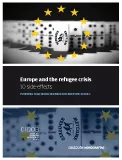THE DIVIDE BETWEEN EAST AND WEST DEEPENS

It has been written that the refugee crisis has divided Europe into two. This exemplifies the way a clash of civilisations is emerging in the West,1 with part of Europe welcoming those fleeing war and another barring entry; with one side arguing that protection of human rights should take precedence in this humanitarian crisis and the other demanding protection for national and ethnic identities from what is viewed as a threat to European civilisation. The two Europes find their greatest expression in the alliance between the Germany of Merkel and Juncker’s European Commission, on the one hand, and the Hungarian government led by Viktor Orban which is at the head of the Visegrad Group (of which the Czech Republic, Poland and Slovakia also form part), on the other. In Europe, the division between east and west threatens to become the next line of fracture in the European project, after the euro crisis divided the continent between north and south, or creditors and debtors. The end of freedom of movement, the reestablishment of internal borders and the abandonment of the fundamental values of the EU (all basic pillars of the European integration project) could become unwanted effects of the refugee crisis.
On the western side, Germany received the compliments of many when Angela Merkel expressed a willingness to receive up to 800,000 refugees and reform the EU mechanisms for handling the arrival of new waves of migrants, such as, for example, the control of a single European external border or of a common migration and asylum policy. Merkel’s policy took refuge in the need to bypass common European rules in times of humanitarian need and when international conventions such as the Geneva become applicable. The EU cannot hide behind the obsolete Dublin Convention, which obliges refugees to register in the country of entry before being able to move to other European countries. With her open border policy, Merkel allowed hundreds of thousands of refugees to arrive and drew criticism from the members in the east, who accused her of not complying with European regulations in contrast to her mantra of scrupulous respect for the precepts of the monetary union during the euro crisis.
At the same time, the Merkel policy found an ally in Juncker’s commission, which, with its proposal to resettle the asylum applicants among the member states, considered a quota system to be the only way to give a joint European response to the crisis. The Berlin-Brussels axis ended up convincing other member states who were little inclined to the initial sharing out of refugees such as Spain or Portugal, but who preferred to join the western states than aligning themselves with the more belligerent postures of the Visegrad Group. Merkel’s policy, articulated around the non-existence of limits on the right to asylum, soon generated controversy for her at home, with 51% of the German public revealed to be worried by the arrival of new refugees. The insufficient absorption capacity of the asylum processing centres and the complaints of local authorities and of the länder like Bavaria have also made Merkel retreat.
In the east, developments took the opposite course. When Germany and the European Commission sought a common response to the refugee crisis, countries such as Hungary and Poland withdrew into their national (and even ethnic and religious) identities in order to justify a restrictive policy. Their proposals referred to bolstering the EU’s external borders, weakening the pull effect caused by an open arms approach and helping third countries contain the flow of refugees moving towards Europe. They argued that eastern Europe, having already faced an incessant flow of refugees during the Ukrainian crisis, would be unable to take in refugees coming, this time, from conflicts close to Europe’s southern border (read: Syria). Also, the leaders of the Visegrad Group considered that their welfare states and social infrastructures did not allow them to exercise German-style solidarity, much less so if, owing to their distinct cultural roots the conflict would degenerate into rivalries for limited services between local and foreign populations. What is certain is that they were not alone in this stance. Countries such as Denmark, whose asylum policy was previously among the most generous in Europe, showed their support for the thesis from the east, even going as far as publishing official propaganda in Lebanese newspapers to prevent refugees traveling to Denmark.
The adoption of shared refugee quotas by qualified majority in the Justice and Home Affairs Council on September 22nd 2015 (with the Visegrad countries abstaining) was a milestone in intra-European division in the crisis. Germany came to suggest withdrawing cohesion funds from those who refused to act in solidarity with the humanitarian drama of the refugees. The heads of state and government managed to calm the internal divisions in the European Council meeting of October 15th, where the EU forged a minimal agreement for facing the refugee crisis, reinforcing EU borders and promising help to third countries with the containment of flows of migrants and their integration. There was no sign in the council’s conclusions that the EU would move towards the adoption of a common asylum policy or the strengthening of action in the countries where the crisis originated.
Some will be tempted to say that the refugee crisis shows the low level of commitment of the countries in the east to the European project and that, surely, they joined the EU too early. What is certain is that the 2004 European expansion took place shortly before intergovernmental dynamics began to dominate at the heart of the union, above all from the economic crisis onwards. The predominance of national visions and the inability of current leaders to support a common project explain why Europe is not reacting to the crisis affecting its fundamental foundations.